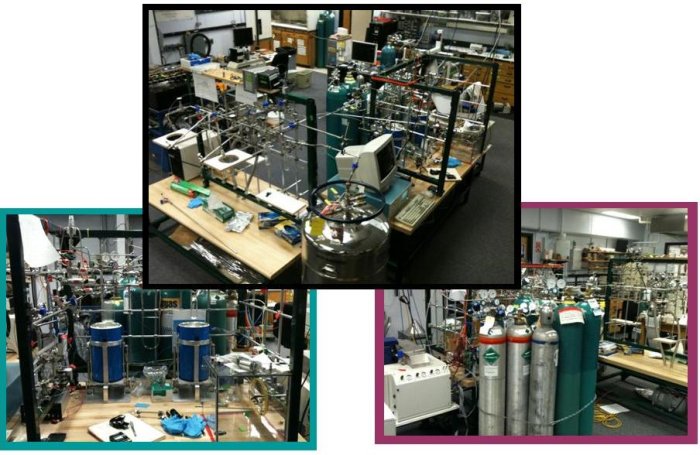Other Isotopes in the Atmosphere: Their Individual Stories
18O in Carbon Dioxide
While NOAA scientists measure the ratio of different carbon isotopes in carbon dioxide, there are also different isotopes of the oxygen atoms as well. The ratio of the two most common oxygen isotopes–16O and 18O–shows the large scale cycling of carbon dioxide between the atmosphere and different surface sinks. δC18OO (just meaning the delta ratio of different oxygen isotopes in carbon dioxide) is highly variable and fluctuates a great deal, making it much harder to interpret than the carbon isotopic ratios. Even so, oxygen isotopic ratios show isotopic exchange with leaf water and soil water 8.
Recall that stable carbon isotopes in carbon dioxide tell whether the terrestrial biosphere is a sink or source of carbon dioxide overall. Well, oxygen isotopes have the potential to actually show how much atmospheric carbon dioxide is used up during photosynthesis versus how much is respired out again from the vegetation–really helping scientists better understand the role of the terrestrial biosphere in the carbon cycle!

Oxygen and Carbon Isotopes in Carbon Monoxide
Carbon monoxide (CO) is another important trace gas in the atmosphere. While it does not play a significant role as a greenhouse gas, its concentrations strongly influence the overall chemistry of the atmosphere. This is because CO is removed from the atmosphere by its reaction with atmospheric hydroxyl radicals (OH). Hydroxyl radicals are very reactive and are effectively the “cleansing agent” of the atmosphere, acting to remove a large range of greenhouse gases and atmospheric pollutants. In relatively clean air, OH reacts primarily with CO. In this way CO concentrations can indirectly control the concentrations of numerous other gases, such as methane and HCFCs (Hydrochlorofluorocarbons).

While we know the main sources of CO to the atmosphere (combustion, oxidation of atmospheric methane and other hydrocarbons) as well as how CO is removed (reaction with OH), there are still considerable uncertainties in the magnitudes of these terms. Stable isotopic measurements of atmospheric CO can help to better understand how CO is changing in the atmosphere, where it is coming from, and where it is going. For example, 13C/12C ratio of CO is a good tracer for CO from methane oxidation, as CO from this source has less 13C as compared to other sources. The 18O/16O ratio of CO is a good tracer for CO from combustion, as this source has more 18O as compared to other sources. Further, after some fraction of the CO molecules is removed by reaction with OH, the remaining CO has relatively more 13C, and relatively less 18O.
To learn more about the role of OH and 14CO in our atmosphere, please refer to the Manning et al. paper–which is the tenth reference in the “References” section.
Carbon and Hydrogen Isotopes in Methane: From a Few Sources to Many
Methane (CH4) is the next most important greenhouse gas after carbon dioxide. Although there is much less of it in the atmosphere than carbon dioxide, it is a very strong greenhouse gas. Methane has a global warming potential (over the next 100 year time period) per kg of methane emissions that is 25 times that of a kg of carbon dioxide 1. The amount of methane in the atmosphere has doubled in the last 150 years. The story behind methane is extremely complex; not only does methane have many, many more sources than carbon dioxide, but it also is reactive 11. In the atmosphere, methane is removed through a chemical reaction (CH4 + OH → CH3 + H2O)–but the rate of this reaction also varies, significantly complicating the story.
Methane is produced through three main sources: microbial production, fossil fuel exploitation (e.g., leaky natural gas pipe lines or coal mines), and biomass burning 11. Each of these sources can be broken down into multiple components, both human-caused and natural. Just as an example, microbial production comes from waste decomposition, wetlands, livestock, rice paddies, and wild ruminants and termites–just to name a few of the many sources.
The δ13C, Δ14C and δ2H values differ from for each source, providing each with its own isotopic fingerprint 8. Additionally, the atmospheric chemical reaction has an isotopic fingerprint as well. These different fingerprints are used to determine the relative strength of each source and the rate of the chemical reaction, showing scientists how methane is both added to and removed from the atmosphere. For example, measurements of isotopes in methane extracted in bubbles of air in ice cores have been used to show that in the past, although the amount of methane stayed constant, there was a change in mixture of sources through time 12. Measurements of 14C could potentially be used to indicate increased emissions of CH4 from permafrost, where large amounts of carbon have been frozen for tens of thousands of years.
| Greenhouse Gas | Isotopic Measurement | Detective Work |
|---|---|---|
|
Carbon Dioxide (CO2) |
18O |
|
|
Carbon Monoxide (CO) |
18O, 14C |
|
|
Methane (CH4) |
13C, 14C, 2H |
|

 Previous
Previous
